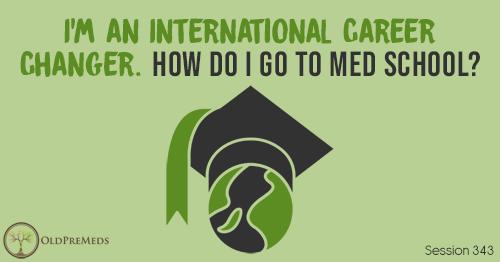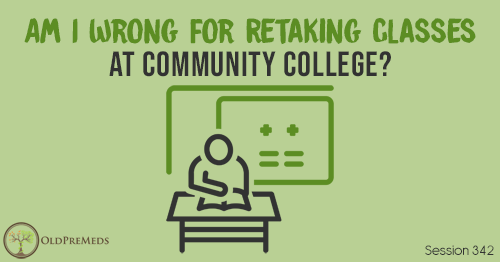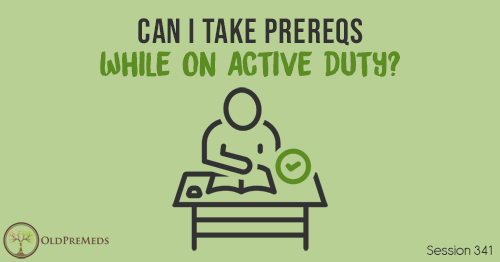Apple Podcasts | Google Podcasts
Session 314
This non-trad wants to know if nontrads are becoming more common.
Questions answered here on the podcast are taken directly from the Premed Hangout. Go ask your questions there and use #OPMquestion.
Also, please be sure to check out all our other podcasts on Meded Media as we try to bring you as many resources as you need on this journey.
Listen to this podcast episode with the player above, or keep reading for the highlights and takeaway points.
[00:53] The MCAT Minute
The MCAT Minute is brought to you by Blueprint MCAT.
Historically, mid-October is when registration dates are open to save your spot for a January, March, or April MCAT. If you’re taking the MCAT in January, March, or April, October is when you want to start looking at your registration for the MCAT. Go save that seat to make sure you have a spot in your local testing center. That way, you don’t have to travel, stay at a hotel, and get a sleepless night before your test.
Go sign up for a free account at Blueprint MCAT and get access to a host of free resources including their study planner tool to make sure your study plan is set.
[02:16] OldPreMeds Question of the Week
“Are nontrads becoming more common?”
The question is, what does that do for you? How does that help you on your journey to medical school? It probably doesn’t help in any way. But let’s try to answer this question for the sake of answering it.
[02:55] The Definition of a Nontrad
First off, let’s try to define what a nontrad is. It’s a very nonspecific term that we just throw around, as anyone who doesn’t go down the normal path of high school to undergrad. You apply to medical school during the junior year of your undergrad and graduate in your last semester, then start medical school right after that.
That is the typical definition of a traditional student. And so, anyone who doesn’t follow that path is perhaps a nontraditional student.
'The definition of a nontraditional student is someone who doesn't go straight from undergrad to medical school.'Click To TweetUnfortunately, AAMC doesn’t give a lot of archive data on this. But the AAMC has a Matriculating Student Questionnaire (MSQ) for medical schools to offer medical students. It’s data for the AAMC to do research, publish, and provide to other students as well as medical schools.
Each MSQ includes three years’ worth of data. So far, they have released the 2016 and 2021 data. So from 2014 to 2021, we can see what the trends look like.
In 2014, the students who took less than one year between graduation from undergrad and the start of medical school was 42.1%. 36.4% took one to two years, 12.6% took three to four, and then 8.9% took five or more years off.
[06:35] Breaking Down MSQ Data
Taking a look at the 1-2 years data which is 36.4%, it went up to 38.3% in 2015 and 39.4% in 2016. 41.4.% in 2017, 42.7% in 2018, 43.9% in 2019, 44.1 in 2020, and 44.8% in 2021.
Remember though that this is survey data. So it’s not always the best data. Again, 36.4% of students said that they took between one to two years off between graduating undergrad and starting medical school. And in seven years, that went up almost eight and a half percentage points to 44.8%.
For the data where students said that they took between three to four years off between graduating undergrad and starting medical school, it went up from 12.6% to 15.2%.
The “more than five years” stayed flat at 8.9% then 8.5% and it dropped down to 7.9% at one point, and it’s 8.5% now.
And for the “less than one year” or the “traditional” person, 42.1% in 2014 dropped down to 31.4% in 2021.
Ultimately, we don’t know why this is happening. Some students may interpret this data thinking it’s better to be a nontrad since more people are nontraditional. But you can’t really make that conclusion.
[09:40] Possible Reasons for the Trend
The change of people going straight from undergrad to medical school can have a lot of different reasons.
One reason could be that life is just getting more hectic, there’s more stress and more confusion about this process. And the MCAT is something that people are taking a lot more seriously because they’re understanding the ramifications of a good MCAT score and a bad MCAT score.
'More and more, I'm hearing students delay applying to medical school. They are purposefully taking a gap year so that they can take the MCAT after they graduate college.'Click To TweetOne of the reasons why students are taking more time between graduating college and starting medical school is they’re just taking the MCAT when they’re not taking classes.
That doesn’t mean it’s better to take the MCAT without taking classes. It just means that there is a potentially larger percentage of people who are taking the MCAT out of college or once they graduate.
Again, this data doesn’t give us why. It’s just numbers. So don’t read into this and make the conclusion that it’s better to be a nontrad because the majority of the students are.
And so, back to the question of whether there are more students becoming nontrads, the answer is yes. As to why that is, we don’t know. So you can’t make the conclusion that it’s better to be a nontrad.












